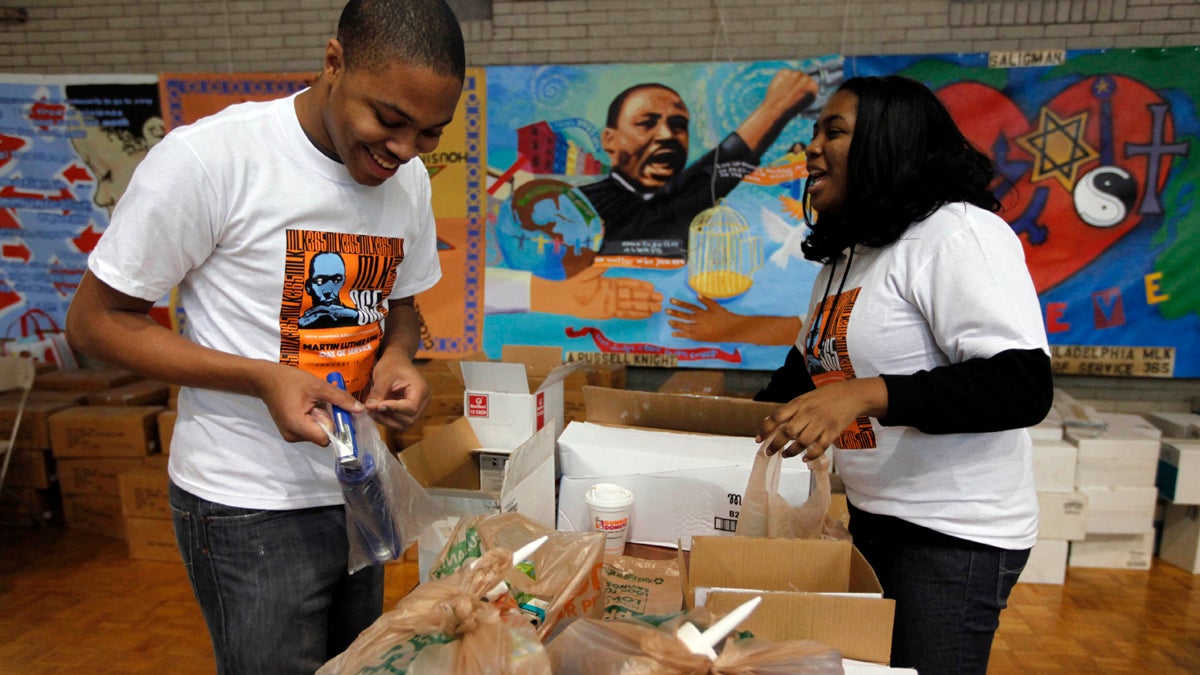Ideas Worth Stealing: Cities can mobilize volunteers, but figuring out how is key

Volunteers Malcolm Kenyatta and Kylie Patterson assemble home weatherization kits during the Greater Philadelphia Martin Luther King Day of Service, at Girard College. (AP File Photo/Matt Rourke)
For cities with tight budgets, harnessing the power of volunteers effectively can help get things done.
Ideas Worth Stealing: Every week, Keystone Crossroads will look to cities across the world for lessons in urbanism and municipal governance that could benefit Pennsylvania. No city does it all right, and we hope these examples from metropolises near and far inspire and encourage cities here to think outside the box.
In communities with increasingly strained budgets, citizens and municipal governments have turned more frequently to unconventional means to get things done. For example, Keystone Crossroads previously reported that citizens and governments are using crowdfunding to complete civic projects that budgets don’t cover. We also reported that some municipalities are merging to leverage limited resources. And most recently, we ran a story about the city of Pittsburgh using volunteers to help evaluate its vertical infrastructure, i.e. steps.
Volunteerism is as American as apple pie — think volunteer firefighters, for example. Pennsylvania, a largely rural state, has a whole network of safety-focused volunteers. According to the Corporation for National and Community Service, more than 60 million Americans volunteer annually. In Pennsylvania nearly 30 percent of residents volunteer, which ranks the Commonwealth about average (26th) among the states and Washington, D.C. (the rate of volunteerism is just below the state average in Philadelphia and just above average in Pittsburgh).
A 2010 International City/County Management Association (ICMA) report notes that nationally, volunteerism is evolving and demand for it growing. Cities are struggling, but “despite financial conditions, cities must maintain core programs and respond to citizens’ pressing needs,” the report states. “In addition, a priority for many city leaders is to build social capital within their jurisdictions and help citizens positively connect to government — an especially difficult challenge during economic downturn. Volunteerism provides a key way to support both of these goals.”
The report also mentions a perfect storm of conditions that could help communities maximize volunteerism: the passing of the Serve America Act in 2009 (which expanded national service programs), the rise of community-conscious millennials, and millions of retiring baby boomers looking for new ways to spend their time.
Best practices
All this got us wondering: what are the best practices for communities managing volunteer efforts to accomplish their goals?
Cities of Service has compiled a playbook outlining best practices. Cities of Service is a nonprofit that formed after the Serve America Act passed, to work with cities on improving their volunteer programs. Deputy Director for Cities of Service, Peter Goldwasser, said volunteerism doesn’t replace city services, but rather taps into new partnerships to get things done. Allentown, Easton, Farrell, Harrisburg, Parker, Philadelphia, Pittsburgh, Reading, Wilkes-Barre, and York all participate.
According to their playbook, communities need to have certain things in place to make the most of their volunteers. That includes a mayor or chief executive who participates in planning programs and dedicates a staff member to oversee the work; a focused area of need and citizen input to confirm that the correct priorities have been identified; an effort to engage stakeholders, including local organizations, to develop initiatives and identify structural problems that need to be overcome; and metrics to measure progress. ICMA adds that marketing and public relations campaigns about the volunteer programs and their successes can help the initiatives stay on target and attract enthusiastic volunteers. Basically, it comes down to being focused and deliberate, and measuring impact.
Cities of Service cited Pittsburgh’s Love Your Block program as one successful initative. Pittsburgh’s volunteer office, called ServePGH, solicits plans from nonprofit organizations to improve a city block. Winners are awarded $1,000 for their project — the money comes from private partners, in this case People’s Gas — and receive support from relevant municipal agencies. Pittsburgh has an engaged mayor, a dedicated point of contact for the initiatives, various partners, and Cities of Service’s Alice Kamens said the city has established some best practices, as well. One, the city hosts information sessions for the Love Your Block program and, two, it gives an additional $2,000 to the best Love Your Block project. Those incentives are meant to encourage groups to go above and beyond.
WHYY is your source for fact-based, in-depth journalism and information. As a nonprofit organization, we rely on financial support from readers like you. Please give today.


